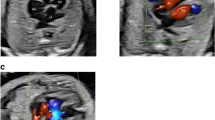Abstract
Discordant atrioventricular and ventriculoarterial connection(s) (DAVVAC) are a rare group of congenital heart lesions. DAVVAC can be isolated or associated with a variety of other cardiac abnormalities. Previous studies examining the outcome of prenatally diagnosed DAVVAC have described only fetal and early postnatal outcome in small cohorts. We aimed to describe the medium-term outcome of these fetuses. Cases were identified by searching the fetal cardiac databases of two centers. Follow-up data were collected from the electronic patient records. We identified 98 fetuses with DAVVAC. 39 pregnancies were terminated and 51 resulted in a liveborn infant. Postnatal data were available for 43 patients. The median length of follow-up was 9.5 years (range 36 days to 22.7 years). The overall 5-year survival of the cohort was 80% (95% confidence interval 74–86%), no deaths were seen after this period. Associated cardiac lesions had a significant effect on both survival and surgery-free survival. Isolated DAVVAC and DAVVAC with pulmonary stenosis ± ventricular septal defect had a low mortality (89% and 100% 5-year survival, respectively). Poorer survival was seen in the group with Ebstein’s anomaly of the tricuspid valve, and other complex cardiac abnormalities. Antenatal tricuspid regurgitation had a significant negative impact on postnatal survival. In conclusion, the short- and medium-term outlook for fetuses with isolated DAVVAC, and those with DAVVAC and pulmonary stenosis are good. Antenatal risk factors for postnatal mortality include Ebstein’s anomaly of the tricuspid valve, especially if associated with tricuspid regurgitation, and the presence of complex associated lesions.





Similar content being viewed by others
References
Paladini D, Volpe P, Marasini M et al (2006) Diagnosis, characterization and outcome of congenitally corrected transposition of the great arteries in the fetus: a multicenter series of 30 cases. Ultrasound Obstet Gynecol 27:281–285. https://doi.org/10.1002/uog.2715
Sharland G, Tingay R, Jones A, Simpson J (2005) Atrioventricular and ventriculoarterial discordance (congenitally corrected transposition of the great arteries): echocardiographic features, associations, and outcome in 34 fetuses. Heart 91:1453–1458. https://doi.org/10.1136/hrt.2004.052548
Allan LD, Sharland GK, Milburn A et al (1994) Prospective diagnosis of 1,006 consecutive cases of congenital heart disease in the fetus. J Am Coll Cardiol 23:1452–1458. https://doi.org/10.1016/0735-1097(94)90391-3
Rutledge JM, Nihill MR, Fraser CD et al (2002) Outcome of 121 patients with congenitally corrected transposition of the great arteries. Pediatr Cardiol 23:137–145. https://doi.org/10.1007/s00246-001-0037-8
Chiappa E, Micheletti A, Sciarrone A et al (2004) The prenatal diagnosis of, and short-term outcome for, patients with congenitally corrected transposition. Cardiol Young 14:265–276
Wan AW, Jevremovic A, Seda E et al (2009) Comparison of impact of prenatal versus postnatal diagnosis of congenitally corrected transposition of the great arteries. Am J Cardiol 104:1276–1279. https://doi.org/10.1016/j.amjcard.2009.06.047
Egloff L, Rothlin M, Arbenz U et al (1980) Congenitally corrected transposition of the great arteries: a clinical and surgical study. Thorac Cardiovasc Surg 28:228–232
Graham TP, Bernard YD, Mellen BG et al (2000) Long-term outcome in congenitally corrected transposition of the great arteries. J Am Coll Cardiol 36:255–261. https://doi.org/10.1016/S0735-1097(00)00682-3
Lundstrom U, Bull C, Wyse RKH, Somerville J (1990) The natural and “unnatural” history of congenitally corrected transposition. Am J Cardiol 65:1222–1229. https://doi.org/10.1016/0002-9149(90)90978-A
Bjarke BB, Kidd BS (1976) Congenitally corrected transposition of the great arteries. A clinical study of 101 cases. Acta Paediatr Scand 65:153–160. https://doi.org/10.1177/1073191116659134
Cools B, Brown SC, Louw JJ et al (2012) Pulmonary artery banding as “open end” palliation of systemic right ventricles: an interim analysis. Eur J Cardio-thoracic Surg 41:913–918. https://doi.org/10.1093/ejcts/ezr078
Kutty S, Danford DA, Diller GP, Tutarel O (2018) Contemporary management and outcomes in congenitally corrected transposition of the great arteries. Heart 104:1–8. https://doi.org/10.1136/heartjnl-2016-311032
Orchard EA, Ormerod O, Myerson S, Westaby S (2010) Congenitally corrected transposition of the great arteries presenting in a nonagenarian. Circulation. https://doi.org/10.1161/CIRCULATIONAHA.109.919068
Matsumura Y, Kawahito K, Nakamura K, Hashimoto K (2013) Congenitally corrected transposition of the great arteries with coexisting aortic valve stenosis in a 77-year-old woman. Eur J Cardio-thoracic Surg 43:442. https://doi.org/10.1093/ejcts/ezs477
Brizard CP, Lee A, Zannino D et al (2017) Long-term results of anatomic correction for congenitally corrected transposition of the great arteries: a 19-year experience. J Thorac Cardiovasc Surg 154:256–265.e4. https://doi.org/10.1016/j.jtcvs.2017.03.072
Hiramatsu T, Matsumura G, Konuma T et al (2012) Long-term prognosis of double-switch operation for congenitally corrected transposition of the great arteries. Eur J Cardio-thoracic Surg 42:1004–1008. https://doi.org/10.1093/ejcts/ezs118
Murtuza B, Barron DJ, Stumper O et al (2011) Anatomic repair for congenitally corrected transposition of the great arteries: a single-institution 19-year experience. J Thorac Cardiovasc Surg 142:1348–1357.e1. https://doi.org/10.1016/j.jtcvs.2011.08.016
Sharma R, Talwar S, Marwah A et al (2009) Anatomic repair for congenitally corrected transposition of the great arteries. J Thorac Cardiovasc Surg 137:404–412.e4. https://doi.org/10.1016/j.jtcvs.2008.09.048
Author information
Authors and Affiliations
Corresponding author
Ethics declarations
Conflict of interest
None of the authors have any conflict of interest with respect to this paper.
Additional information
Publisher's Note
Springer Nature remains neutral with regard to jurisdictional claims in published maps and institutional affiliations.
Rights and permissions
About this article
Cite this article
Day, T.G., Woodgate, T., Knee, O. et al. Postnatal Outcome Following Prenatal Diagnosis of Discordant Atrioventricular and Ventriculoarterial Connections. Pediatr Cardiol 40, 1509–1515 (2019). https://doi.org/10.1007/s00246-019-02176-2
Received:
Accepted:
Published:
Issue Date:
DOI: https://doi.org/10.1007/s00246-019-02176-2




